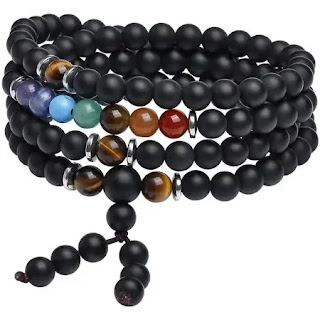A mala is a string of beads that is used for meditation and prayer. Malas have been used for thousands of years in many different cultures and religions. The word "mala" comes from the Sanskrit word for "garland," and it is believed that the beads represent the cycle of life.
Malas are typically made with 108 beads, although there are some variations. The number 108 is considered to be a sacred number in many cultures, and it is believed to represent the perfection of the universe.
Malas are used for a variety of purposes, including:
- Meditation: Malas can be used to help you focus your attention and stay present during meditation.
- Prayer: Malas can be used to help you pray and connect with your spiritual beliefs.
- Counting: Malas can be used to count repetitions of mantras or other prayers.
- Wear: Malas can also be worn as jewelry, as a reminder of your spiritual practice.
If you are interested in using a mala, there are a few things you should keep in mind:
- Choose a mala that feels right for you: There are many different types of malas available, so take some time to find one that you like. The material, size, and color of the beads are all important factors to consider.
- Use your mala with intention: When you use your mala, do so with intention. This means focusing on your meditation or prayer and being mindful of your thoughts and feelings.
- Treat your mala with respect: Malas are sacred objects, so it is important to treat them with respect. This means keeping them clean and safe, and not using them for anything other than their intended purpose.
Here are some additional details about the history and use of malas:
- History: Malas have been used for thousands of years in many different cultures and religions. The earliest evidence of malas dates back to the Indus Valley Civilization, which flourished from 3300 to 1300 BCE. Malas have been found in archaeological sites in India, Tibet, China, and other parts of Asia.
- Use: Malas are used for a variety of purposes, including meditation, prayer, and counting. In meditation, malas can be used to help you focus your attention and stay present. In prayer, malas can be used to help you connect with your spiritual beliefs. Malas can also be used to count repetitions of mantras or other prayers.
- Material: Malas can be made from a variety of materials, including wood, stone, metal, and seeds. The material of the beads can be chosen based on personal preference and the intended use of the mala. For example, wood beads are often chosen for their calming and grounding properties, while stone beads are often chosen for their strength and durability.
- Size: Malas can vary in size, but they typically have 108 beads. The number 108 is considered to be a sacred number in many cultures, and it is believed to represent the perfection of the universe.
- Color: Malas can also vary in color. The color of the beads can be chosen based on personal preference and the intended use of the mala. For example, blue beads are often chosen for their calming and soothing properties, while red beads are often chosen for their energy and passion.
- Wear: Malas can also be worn as jewelry, as a reminder of your spiritual practice. When wearing a mala, it is important to keep it clean and safe. You may also want to consider purchasing a mala bag or pouch to store your mala when it is not in use.
The Spiritual Significance of 108
The number 108 has a special significance in many different cultures and religions. It is considered a sacred number, and it is often associated with the cycle of life, the universe, and the spiritual journey.
- In Hinduism, 108 is considered to be the number of sacred syllables in the Sanskrit alphabet. These syllables are called mantras, and they are believed to have the power to create and transform reality.
- In Buddhism, 108 is considered to be the number of knots in the Buddha's umbilical cord. These knots represent the 108 fetters, or attachments, that bind us to suffering. By meditating on the 108 fetters, we can free ourselves from suffering and achieve enlightenment.
- In Jainism, 108 is considered to be the number of vows that Jain monks and nuns take. These vows are designed to help Jains live a life of non-violence and compassion.
The number 108 is also associated with the following:
- The number of petals on a lotus flower
- The number of beads in a mala
- The number of days in a lunar month
- The number of years in a Vedic cycle
- The number of chakras in the human body
The number 108 is a powerful number with a rich history and symbolism. When used in a mala, the number 108 can help to promote spiritual growth and development.
Other spiritual significance of 108:
- The lotus flower: The lotus flower is a symbol of purity and enlightenment. It is believed that meditating on the lotus flower can help to achieve spiritual liberation.
- The mala: A mala is a string of beads that is used for meditation and prayer. Malas are typically made with 108 beads, although there are some variations. The number 108 is considered to be a sacred number in many cultures, and it is believed to represent the perfection of the universe.
- The lunar month: The lunar month is the period of time between two new moons. It is typically 29.5 days long. The number 108 is equal to the number of days in two lunar months.
- The Vedic cycle: The Vedic cycle is a period of time that is 5,125 years long. It is believed that the universe goes through a cycle of creation, destruction, and rebirth every 5,125 years. The number 108 is equal to the number of years in two Vedic cycles.
- The chakras: The chakras are energy centers in the human body. There are seven main chakras, and each chakra is associated with a different aspect of our physical, emotional, and spiritual well-being. The number 108 is equal to the number of chakras in the human body.
How to Choose a Mala
When choosing a mala, it is important to choose one that feels comfortable and resonates with you. You may want to consider the following factors when choosing a mala:
- The material of the beads: The material of the beads can have a significant impact on the overall feel and experience of using the mala. Some popular materials include:
- Wood: Wood is a natural material that is often associated with strength, stability, and grounding. Wood beads can be a good choice for those who are looking for a mala that is both beautiful and functional.
- Stone: Stone beads are another popular choice for malas. Stone is a natural material that is often associated with different properties, such as healing, protection, and wisdom. When choosing stone beads, it is important to consider the properties that you are looking for in a mala.
- Seed: Seed beads are a natural and affordable option for malas. Seed beads are often made from materials such as rudraksha, bodhi, and lotus seeds. These beads can be a good choice for those who are looking for a mala that is both affordable and meaningful.
- Metal: Metal beads are a beautiful and durable option for malas. Metal beads can be made from a variety of materials, such as gold, silver, and copper. These beads can be a good choice for those who are looking for a mala that is both stylish and functional.
- The size of the beads: The size of the beads is another important factor to consider when choosing a mala. The beads should be large enough to be easy to hold and count, but not so large that they are uncomfortable to wear. A good rule of thumb is to choose beads that are about the size of a pea.
- The color of the beads: The color of the beads is a matter of personal preference. Some people choose to choose beads that match their favorite color, while others choose beads that have a special meaning to them. There is no right or wrong answer when it comes to the color of the beads.
- The price: Malas can range in price from a few dollars to hundreds of dollars. The price of a mala will depend on the materials used, the size of the beads, and the craftsmanship. It is important to choose a mala that fits your budget and your needs.
Other tips for choosing a mala:
- Choose a mala that is made from natural materials. This is because natural materials are believed to have positive energy and vibrations.
- Choose a mala that is the right size for you. The beads should be large enough to be easy to hold and count, but not so large that they are uncomfortable to wear.
- Choose a mala that is made with beads of equal size. This will help you to keep track of your progress during meditation.
- Choose a mala that is pleasing to your eye. You should like the way the mala looks and feels.
- Choose a mala that you feel drawn to. When you see a mala that you are drawn to, it is a sign that it is the right mala for you.
How to Use a Mala
Malas can be used for a variety of purposes, including meditation, prayer, and counting. Here are some tips on how to use a mala:
- Find a quiet place where you will not be disturbed. This is important for creating a peaceful and distraction-free environment for your meditation.
- Sit in a comfortable position with your back straight. This will help you to relax and focus during your meditation.
- Hold the mala in your dominant hand. The mala should be held in your dominant hand so that you can easily count the beads and repeat your mantra.
- Start at the guru bead and begin to count the beads one at a time. The guru bead is the large bead that is usually located at the end of the mala. It is traditional to start counting at the guru bead and then work your way down the mala.
- As you count each bead, repeat a mantra, prayer, or affirmation. The mantra, prayer, or affirmation can be anything that is meaningful to you. It can be a simple word or phrase, or it can be a longer prayer or meditation.
- When you reach the end of the mala, start again at the guru bead. You can continue to meditate or pray for as long as you like. There is no right or wrong amount of time to meditate or pray.
Here are some additional tips for using a mala:
- It is traditional to use the right hand when using a mala. This is because the right hand is associated with the sun and with positive energy.
- You can either hold the mala in your palm or wrap it around your fingers. There is no right or wrong way to hold the mala. The most important thing is that you are comfortable and that you can easily count the beads.
- It is not necessary to use the same mantra, prayer, or affirmation every time you use your mala. You can use any mantra, prayer, or affirmation that is meaningful to you. You can also use your mala to count repetitions of other activities, such as yoga poses or breathing exercises.
- When you are finished using your mala, you can place it in a special place or carry it with you as a reminder of your spiritual practice. It is traditional to place the mala in a special place, such as an altar or a shrine. You can also carry the mala with you as a reminder of your spiritual practice.
Benefits of Using a Mala
Malas have been used for centuries for a variety of purposes, including meditation, prayer, and counting. There are many benefits to using a mala, including:
- Meditation: Malas can help you to focus your attention and to quiet your mind during meditation. When you are meditating, it is easy for your mind to wander. Malas can help you to keep your focus by providing a physical object to focus on. As you count the beads on your mala, you can use this as an opportunity to bring your attention back to the present moment.
- Prayer: Malas can help you to remember your prayers and to keep your focus during prayer. When you are praying, it is easy to forget what you are praying for. Malas can help you to keep your focus by providing a physical object to count on. As you count the beads on your mala, you can use this as an opportunity to repeat your prayers or to focus on your intention.
- Counting: Malas can be used to count repetitions of other activities, such as yoga poses or breathing exercises. If you are trying to do a set number of yoga poses or breathing exercises, it can be helpful to use a mala to keep track. This will help you to stay on track and to avoid getting lost in the counting.
- Spiritual practice: Malas can be used as a reminder of your spiritual practice and to help you to connect with your higher power. Malas are often used in religious and spiritual practices. They can be a reminder of your commitment to your faith and to your spiritual journey. Malas can also be used as a tool to help you to connect with your higher power. As you focus on the beads of your mala, you can use this as an opportunity to pray, to meditate, or to simply connect with your inner self.
Here are some additional benefits of using a mala:
- Malas can help you to relax and de-stress. The act of counting the beads on a mala can be a very calming and relaxing experience. It can help to take your mind off of your worries and to focus on the present moment.
- Malas can help you to improve your focus and concentration. As you focus on the beads of your mala, you are training your mind to focus and to concentrate. This can be helpful in all areas of your life, from your work to your relationships.
- Malas can help you to increase your self-awareness and self-compassion. As you use your mala, you are taking the time to focus on yourself and on your inner self. This can help you to increase your self-awareness and to develop more compassion for yourself.
- Malas can help you to connect with your inner wisdom and intuition. As you use your mala, you are creating a space for yourself to connect with your inner wisdom and intuition. This can help you to make better decisions and to live a more fulfilling life.
- Malas can help you to live a more mindful and present life. The act of using a mala can help you to be more mindful and present in the moment. This can help you to appreciate the simple things in life and to live a more fulfilling life.
If you are looking for a way to improve your meditation practice, prayer life, or overall well-being, I encourage you to try using a mala. Malas are a simple and effective tool that can help you to connect with your inner self and with the divine.
Where to Buy a Mala
Malas can be found in a variety of places, including:
- Religious and spiritual stores: Religious and spiritual stores often sell malas. These stores may be located in your local community or online.
- Yoga and meditation studios: Yoga and meditation studios often sell malas. These studios may be located in your local community or online.
- Online retailers: There are a number of online retailers that sell malas. These retailers may offer a wider variety of malas than you would find in a local store.
If you are interested in buying a mala in Amazon, CLICK HERE to buy now.
Here are some tips for finding a mala:
- Do your research: There are many different types of malas available, so it's important to do your research before you buy one. Consider the materials, size, and price of the mala when making your decision.
- Shop around: There are many different places to buy malas, so it's worth shopping around to find the best deal. You can find malas at religious and spiritual stores, yoga and meditation studios, and online retailers.
- Trust your intuition: When you're looking for a mala, it's important to trust your intuition. If you see a mala that you're drawn to, it's probably the right one for you.








0 Comments